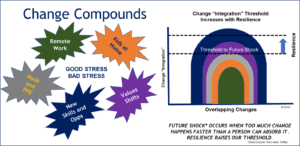
One of my favorite thought leaders on productivity, Darren Hardy, had a great question recently in a daily mentoring segment. He asked,
“What is the size of the problem that stresses you out?”
His point is that we all have different trigger levels of stress and how we deal with it determines how much we can accomplish in this life. While I do not always agree that accomplishment is the same as success, I love his point. The way we handle stress and what we allow to push us over the edge makes a significant difference in how we are able to live and work.
Do we get “bent out of shape” when our favorite sports team loses or when someone talks about us in gossip? Or do we have a higher threshold for stress that only kicks in when more complex challenges arise? During this time, we are seeing stress levels at new heights, a literal pressure cooker for many people. The reason is that change is compounding for us, pushing us closer than ever to our stress tolerance levels.
Alvin Toffler created a term back in 1970 called “Future Shock”. Essentially, it is the point where we can no longer adapt to change because it is too much at once. Today we are experiencing exponential shifts in every aspect of our lives, and it all compounds and builds on itself creating a point of “overload” to which we can no longer adapt. With remote work, kids at home, use of personal protection equipment AGAIN, the return to family values and new skills, many of us are hitting a point of overwhelm, even for the good stuff! The pressure cooker is at the boiling point and we feel ready to explode.
As many change strategists, including experts like Daryl Conner tell us, this threshold of “future shock” holds people and organizations back from being agile and adapting readily to new conditions. The solution is to build up our personal and organizational resilience so we can take on the levels of change now required for all of us, to keep us from boiling over and allowing us to integrate this new world.

Research shows that how we deal with small problems mirrors how we will deal with larger ones. If we freak out over traffic, a messy baby or a technology failure, we will probably have the same reaction when big challenges truly hit. However, if we can use small challenges to practice and build resilience skills, we can handle the big challenges much better. Linda Hoopes provides a great analogy for this. She says that daily life provides a “resilience gymnasium” in her book Prosilience.
Micro challenges like a tech glitch, our weight on the bathroom scale, and wearing a mask AGAIN are the perfect time to build up our adaptability and resilience muscles. We have the opportunity to prepare now for when unforeseen larger changes hit our lives.
I think of how we handle these challenging disruptors (big or small, internal or external) as our ability to “Be Bamboo”. Bamboo is an amazing plant. One inch can hold 7.5 tons of weight and pressure, yet it is so flexible that it can bend and not break under hurricane/typhoon force winds. Interestingly, like resilience and flexibility, Bamboo grows from the inside out. New sprouts come from the root system (versus seeds) and each new shoot is taller and stronger than its predecessors. That is why it’s so hard to get rid of a bamboo forest once it has taken root, as many North American home owners have found out!

This mantra to “Be Bamboo”, when coupled with daily life challenges, provides a roadmap for building both agile organizations and flexible people. Research shows agility leads to long term success for individuals and for businesses.
So how do we “Be Bamboo”? Here are the steps when challenge hits.
1. Calm the Brain
This is step one. Challenges set off our ancient fight, flight or freeze mode, also known as “amygdala hijack”. Before we can do anything else, we need to bring the brain back to a place of rational thought and trigger our parasympathetic nervous system (back to repair and recovery mode versus fight or flight mode).
A few ways to do this include taking deep, deliberate breaths, smiling for 90 seconds, meditation, visualization of something positive, or asking simple and curious questions that are non-judgmental. The point is to get the brain to believe all is well and the danger is over. Most likely the brain is over-reacting anyway, it does that.
2. Bring in Neutral Thinking
Research tells us that as humans, our thoughts go negative first (see “amygdala hijack” and saber-tooth tigers!). This re-enforces our “freak out”. A great skill to build is to see things as neutral versus negative. This allows us to see the facts of the situation versus the emotion around it. By accepting what is and not judging it, we are able to work with it more clearly.
In reality, we often do not even know whether an event is good or bad for the long haul. How many times has someone lost their job only to find their perfect match for their purpose and skills in their next position? Or, they go through an unwanted and messy divorce and later proclaim it was the best thing that could have ever happened to them? We don’t know how things will turn out in the end, so judging the event as good or bad leaves us in a state of turmoil. The Chinese have a great example of this in the fable of the lost horse that shares how situations can change direction very easily. The skill of developing acceptance and neutrality in thought takes a lot of work, but the pay off is tremendous in personal contentment and resilience.
3. Build your Root System
Research shows that building up skills in positivity, confidence in our abilities and a growth mindset are critical to dealing with challenges. In addition, our ability to prioritize based on our purpose, values and goals creates structure and criteria to support us. Resilient individuals also have strong skills in creativity and experimentation, very useful for problem-solving. They know connections and relationships with others can help and that we are not alone. Resilient people usually have systems and methods for creating discipline and routine before a challenge hits, so they are not rocked to their core with every change that comes their way. There are many ways to build these and other resilience abilities. Using our daily challenges as a training ground for practicing resilience is a must!
4. Develop Psychological Safety at Home and Work
Google, one of the most agile companies ever, did an interesting study. They wanted to find out what made teams at Google highly effective. Much to their surprise, the top factor was Psychological Safety! For those not familiar, Psychological Safety is a newer term for the idea that we feel safe to take risks and be vulnerable; that we won’t be punished for making a mistake. When we feel safe, our best abilities come out in creativity, risk-taking and flexibility. It’s a way of “calming the brain” for teams and groups in order to bring in resilience and creativity.
There are many other ways to build resilience and agility skills for individuals and businesses. These are just a few. As we deal with higher levels of stress and challenge, we are given the opportunity to lift up and elevate ourselves, our communities and each other. Like Bamboo, it all starts from the inside out! Join us!
“Nothing is IMPOSSIBLE.
The word itself says “I’M POSSIBLE.”
– Audrey Hepburn





